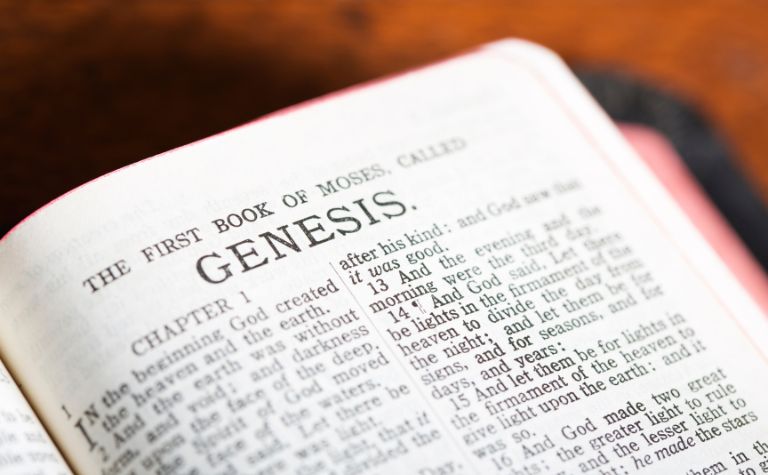Genesis 6:1-4 is one of the most mysterious and debated passages in the first book of the Bible. Many people find that interpreting the verses is challenging because the text doesn’t directly identify the “sons of god” and the “daughters of men” or how the Nephilim relate to them. As a result, even though there is a traditional view of who they are, readers today often disagree about the meaning of these phrases.
According to the traditional Jewish interpretation of the passage, the sons of god in Genesis 6 are fallen angels, a view that the early Christian church also held. Other Jewish scholars think they are human rulers. Other Christian scholars believe the sons of god are godly men from the line of Seth.
What is the biblical support for the three common interpretations? What are the common arguments against each view? How do Genesis scholars describe the challenge of interpreting the identity of the sons of god? Keep reading to learn the answers to these questions and others.
Also see What Is a Serpent in the Bible? to learn more.

What did the sons of god do to the daughters of men?
The beginning of Genesis 6 explains that when the number of women grew upon the earth, the sons of god started marrying them. Genesis 6:1-2 read, “When man began to multiply on the face of the land and daughters were born to them, the sons of God saw that the daughters of man were attractive. And they took as their wives any they chose” (ESV). Some scholars believe the description implies rape.
In response to these marriages, God determined to judge the world with a flood (Gen. 6-9) that would occur in 120 years. Genesis 6:3 reads, “Then the Lord said, ‘My Spirit shall not abide in man forever, for he is flesh: his days shall be 120 years.'” Some scholars believe that Noah (and perhaps his sons) built the ark during the intervening century. Others believe 120 years refers to people having shorter lifespans.
The passage also reveals that the Nephilim were contemporaries of the sons of god and the daughters of men. Who the Nephilim are is the subject of much debate. Genesis 6:4 reads, “The Nephilim were on the earth in those days, and also afterward, when the sons of God came in to the daughters of man and they bore children to them. These were the mighty men who were of old, the men of renown.”
Three views about the identity of the sons of god
There are three main interpretations of the sons of god. Some scholars adamantly support a particular view. Others nuance an existing view or combine more than one. Most scholars, even those who argue for a particular interpretation, often admit to holding to their position loosely because the passage is difficult to understand. The table summarizes the descriptions listed below.
| Strengths | Weaknesses | |
| Fallen angels view | Cross references to Job, 1-2 Peter, and Jude; traditional Jewish view, early Christian view | The flood targeted humans; limitations of angelic and human sexual relations |
| Human rulers view | The Hebrew word for god in the phrase “sons of god” (elohim) describes humans in other passages in the Bible; the flood targeted people, not fallen angels | There is little evidence for this interpretation in the context of Genesis 6 |
| Seth’s line view | Aligns with lineage themes from Genesis 4 and 5; the flood targeted people, not fallen angels | While the Bible calls Seth’s line holy, it doesn’t describe with the phrase “the sons of god” |
Genesis scholar Victor Hamilton speaks for many theologians and historians when he writes, “Suffice it to say, it is impossible to be dogmatic about the identification of ‘sons of god’ here. The best one can do is to consider the options. While it may not be comforting to the reader, perhaps it is best to say that the evidence is ambiguous and therefore defies clear-cut identifications and solutions.” [1]
Also see Why Isn’t the Book of Enoch in the Bible? to learn more.

View #1: The sons of god are fallen angels
The traditional view is that the sons of god are angels that God expelled from heaven for rebelling against him, who then had sexual relations with human women on earth (i.e. “the daughters of men”). According to this view, the Nephilim are the offspring of their union. The Book of Enoch and the Septuagint, which date to approximately the third century before Jesus Christ, reflects this view.
The traditional Jewish interpretation of the passage was the dominant Christian view until the third century after Christ. [2] This view had the support of several leaders in the early Christian church, including Justin Martyr, Irenaeus, Clement of Alexandria, and Tertullian. Chrysostom and Augustine are notable early Christians who disagreed with it, arguing that the sons of god were descendants of Seth.
Genesis scholar Gordon Wenham writes, “The ‘angel’ view is at once the oldest view and that of most modern commentators. It is assumed in the earliest Jewish exegesis, LXX [the Seputagint], Philo, Josephus, and the Dead Sea Scrolls. The NT ( 2 Pet. 2:4; Jude 6, 7) and the earliest Christian writers” to this view. [3]
What is the biblical basis for the sons of god view?
The biblical basis for the view comes from the use of the phrase sons of god in the book of Job, as well as Peter and Jude’s allusions to the story via the Book of Enoch.
Proponents of this view believe that the “sons of god” in Job refer to angels, suggesting that is how readers should interpret the phrase in Genesis 6.
- Job 1:6, “Now there was a day when the sons of God came to present themselves before the LORD, and Satan also came among them” (ESV).
- Job 2:1, “Again there was a day when the sons of God came to present themselves before the LORD, and Satan also came among them to present himself before the LORD” (ESV).
- Job 38:7 says that “the morning stars sang together and all the sons of God shouted for joy” when God laid the foundations of the earth (cf. 38:1).
Advocates also argue that specific New Testament passages teach the view that the sons of god were angels, including 1 Peter 3:19-20; 2 Peter 2:4; and Jude 6, 14-15. Readers who have other interpretations (see below) doubt Peter is reflecting the angelic interpretation. Some conclude that it’s unclear.
Readers who hold the angelic view also see it in Jude 6, which reads, “And the angels who did not stay within their own position of authority, but left their proper dwelling, [God} has kept in eternal chains under gloomy darkness until the judgment of the great day” (ESV). Again, some scholars believe this is a reference to the sons of god as fallen angels, yet others don’t.
What are the common objections to the fallen-angels view?
There are two common objections to this view. First, the reason for the flood, a story that follows in Genesis’ narrative, is to judge people, not angels (Gen. 6:5-8). Second, the Bible doesn’t teach that angels and humans can have sexual relations and produce offspring. Some argue that Jesus teaches they can’t (Matt. 22:29-30; Mark 12:24-25; Luke 20:34-36).
View #2: The sons of god are human judges
Another perspective on the passage, rooted in Jewish interpretation and the view that some Christians today hold, is that the sons of god are human judges or rulers. The Hebrew word translated god (elohim) describes human judges elsewhere in Scripture (e.g. Exod. 21:6), making the interpretation possible.
In this view, the sinful behavior the passage describes isn’t angelic-human sexual relations but polygamy involving people (not fallen angels), rooted in the sin of Lamech (Gen. 4:19). According to this interpretation, the Nephilim aren’t offspring of the sexual unions, but contemporaries of the judges.
Proponents favor this view because it’s less bizarre than angels and humans mating, it’s more consistent with the flood targeting humans (not fallen angels), and it fits better with the theme of preceding passages regarding Seth and Cain’s family lines. The criticism of this view is that the evidence in the passage for interpreting the sons of god as human rulers is weak and, some would say, non-existent.
Also see How Big Was Noah’s Ark? to learn more.

View #3: The sons of god are descendants of Seth
The interpretation that Augustine held, as well as Protestant Reformers like Martin Luther and John Calvin, is that the sons of god were men from the line of Seth. The daughters of men were men from the line of Cain. Therefore, what Genesis 6:1-4 describes is the forbidden union between holy and unholy lines of human beings, which resulted in wicked offspring.
The strengths of this view are that it aligns with the context of Genesis 4 and 5 and avoids the problems associated with the other views. However, one of the significant challenges of the view is that the Bible doesn’t identify the descendants of Seth as “sons of god” anywhere else in Scripture, which some readers think weakens the view.
Also see Where Is Noah’s Ark? to learn more.
References:
[1] Genesis: Chapters 1-17 by Victor Hamilton. p. 265.
[2] Genesis 1-11:26 by Kenneth Mathews. p. 326.
[3] Genesis 1-15 by Gordon Wenham. p. 139.
Related Questions
The Garden of Eden plays an important role in the early chapters of Genesis. God created Adam, planted the garden, and placed the first man in it (Gen. 2:8). God later created Eve and placed her in...
Noah is an iconic figure in the Bible who is known for his righteousness and faith. After God decided to destroy the world with a flood because of how sinful humanity had become, he called Noah to...
